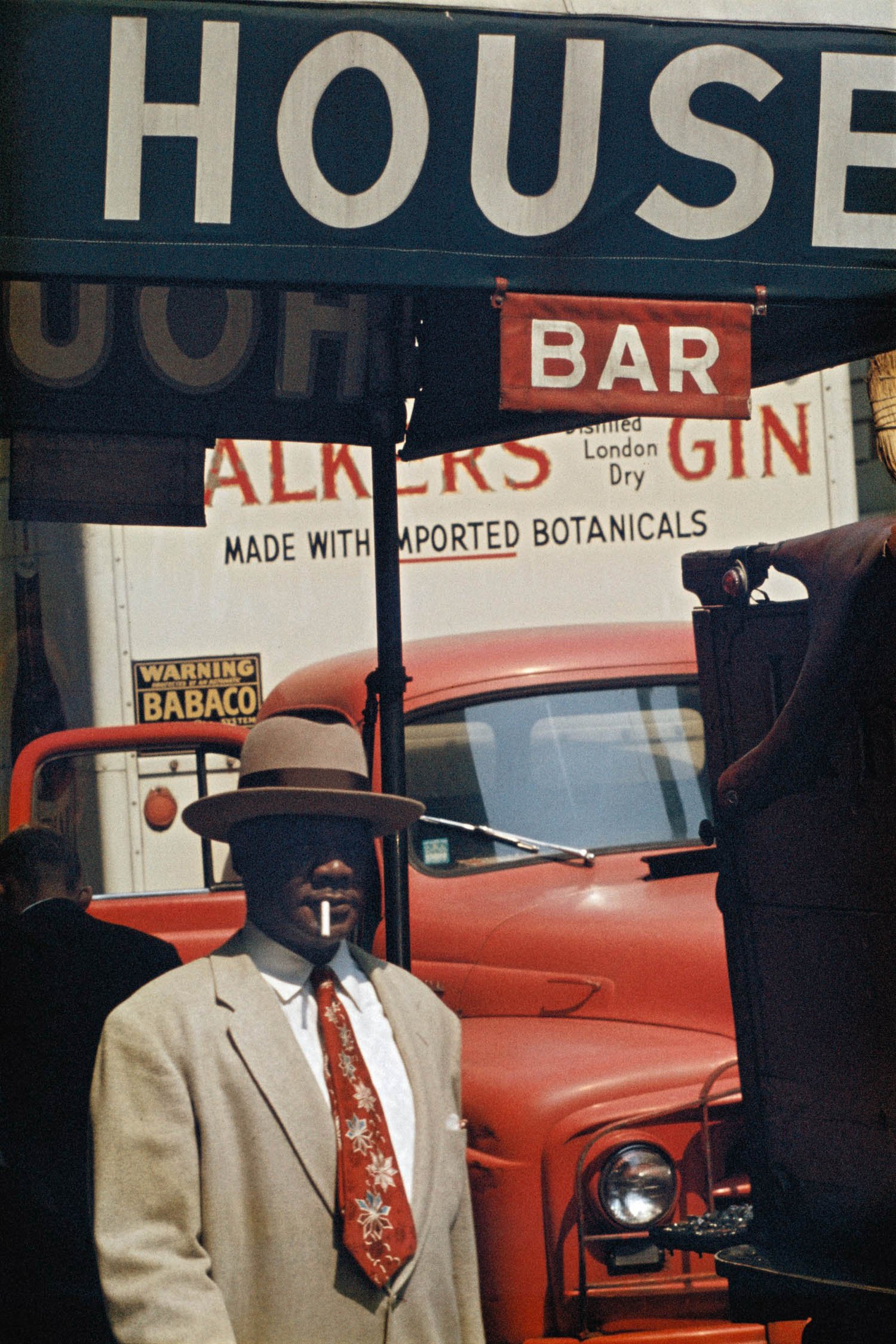Saul Leiter
Saul Leiter
(USA 1923- 2013)
Saul Leiter, Self-Portrait 1950, credit © Saul Leiter Foundation
Saul Leiter was an American painter and photographer known for his photographs of New York City in the late 1940s through the ’60s, and is considered a pioneer of color street photography. Leiter found quiet moments within the urban chaos and portrayed them pictorially. His work has connections to American Abstract Expressionism and the New York School of Photography. His photographs are distinguished by painterly colors, abstract compositions, minimalism, intimacy, and voyeurism, which stands out from the work of his contemporaries like Robert Frank, Diane Arbus, and William Klein. “I take photographs in my neighborhood. I think mysterious things happen in familiar places.”
Saul Leiter, Taxi 1957, credit © Saul Leiter Foundation
Among Leiter’s favorite subjects are passers-by, or their reflections, photographed from shop windows along with umbrellas, snowy days, taxis, signs, and street advertisements, forming abstract compositions in overlapping layers of focus and out of focus. “I happen to believe in the beauty of simple things. I believe that the most uninteresting thing can be very interesting.” In the documentary movie dedicated to Leiter, by Tomas Leach, entitled In No Great Hurry: 13 Lessons in Life with Saul Leiter, at the age of 88 the photographer says, "I may be old-fashioned. But I believe there is such a thing as a search for beauty - a delight in the nice things in the world. And I don’t think one should have to apologize for it.”
Saul Leiter, Red Curtain 1956, credit © Saul Leiter Foundation
One of Leiter's contributions is that he brought a new aesthetic to street photography, using color film in the early '50s, long before it was appreciated in the art scene of the ’70s. For a long time, color was not considered in fine art photography, because the film was expensive and unpredictable in printing. This led many artists to use black and white film, creating the conviction that color film was less artistic. However, Leiter photographed for a long time in color, often using expired Kodachrome film, which gave the photographs a particular hue. For this reason, he is considered a pioneer of color photography. Leiter developed his visual grammar, turning ordinary everyday moments into beautiful abstract images. "I admired a tremendous number of photographers, but for some reason I arrived at a point of view of my own."
Saul Leiter, Snow 1970, credit © Saul Leiter Foundation
Saul Leiter, Postmen 1952, credit © Saul Leiter Foundation
Saul Leiter refused to explain his work. "I don’t have a philosophy, I have a camera." But in return he left us a lot of beautiful expressions that show the nature of an unconventional artist. In an interview he states: “We live in a world full of expectations, and if you have the courage, you ignore the expectations. And you can look forward to trouble.” And Leiter's nature had been unconventional since in his youth, when at the age of 22 he abandoned his theological studies and against his family's wishes he moved to New York from his native Pittsburgh to become a painter. There he found affinity with Abstract Expressionism. After contacts with expressionist painter Richard Pousette-Dart and photographer W. Eugene Smith, he began to take photographs to earn money. The first photos are in black and white of friends and urban scenes. In the 1950s, curator Edward Steichen presented Leiter photographs at the Museum of Modern Art: in 1953, in the exhibition Always the Young Strangers, and in the 1957 slide lecture Experimental Photography in Color. Leiter worked as a fashion photographer for Harper's Bazaar, Elle, British Vogue, and other magazines, where he developed a style similar to his street photography.
Saul Leiter, Mary circa 1947, credit © Saul Leiter Foundation
Saul Leiter, Harper's Bazaar circa 1960, credit © Saul Leiter Foundation
Saul Leiter, Reflection 1958, credit © Saul Leiter Foundation
In the 1980s, Leiter faced financial difficulties and was forced to close his commercial studio. For two decades he worked in silence, painting and photographing in his East Village neighborhood. “I spent a great deal of my life being ignored. I was always very happy that way. Being ignored is a great privilege. That is how I think I learned to see what others do not see and to react to situations differently. I simply looked at the world, not really prepared for anything.”
Saul Leiter, Harlem 1960, credit © Saul Leiter Foundation
Saul Leiter, Mirrors circa 1958, credit © Saul Leiter Foundation
Leiter’s street photography gained attention 50 years after he created many of his works, with the publication of his first book, Early Color, in 2006, followed by the two-volume set Early Black and White in 2014 and the nudes collection In My Room in 2018, along with a series of exhibitions.
The studio of Saul Leiter in New York's East Village, where he worked and lived from 1952 until the end of his life in 2013, has now become home to the Saul Leiter Foundation, which aims to preserve and promote the art and legacy of the photographer. The archive includes thousands of prints, slides, negatives, and paintings, many of which have not yet become known to the public..
Editorial note: We thank the Saul Leiter Foundation for the images provided and assistance in selecting the information: https://www.saulleiterfoundation.org
Sources for Saul Leiter quotations:
Documentary movie from Tomas Leach, In No Great Hurry: 13 Lessons in Life with Saul Leiter:
Interviews:
Saul Leiter in Conversation with Vince Aletti, May 2013
Part 1 - Lecture by Saul Leiter: New York Reflections
Part 2 - Lecture by Saul Leiter: New York Reflections
Part 3 - Lecture by Saul Leiter: New York Reflections
Part 4 - Lecture by Saul Leiter: New York Reflections
podcast from 2006 interview with Mitch Teich on WUWM’s Lake Effect radio show










